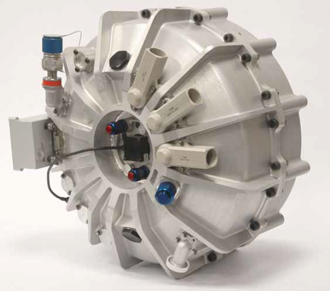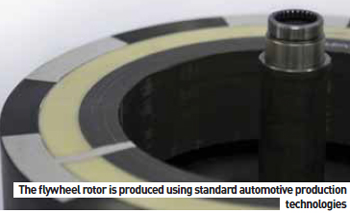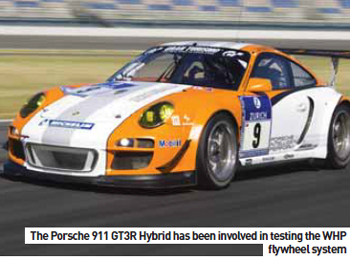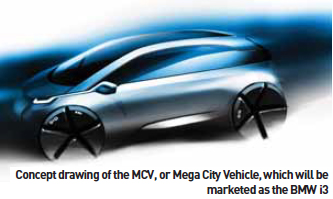Carbon fibre flywheel technology developed by the Williams F1 team could benefit hybrid powertrains, and BMW’s racing expertise is filtering down to the company’s assembly lines
Motor sport, and particularly Formula One, is known for its rapid development of existing technologies, or the formation of entirely new technologies, each eventually making its way back to the series production line as a finished product. The litany of F1’s automotive ‘greatest hits’ is impressive: disc brakes; turbo chargers; fuel injection; ABS; active suspension; paddle-shift gearboxes – the products put forward when the question arises ‘what has motor racing ever done for us’? Yet the problem with this list is that nothing on it is less than 20 years old.
 With it’s reliance on composites and aerodynamic modelling, the last two decades have seen F1 move away from the automotive industry and more like an offshoot of aerospace. While advances in such areas as thin-walled casting and simulation technologies have continued to transfer, the big-ticket items have all but disappeared, though that maybe about to change. For the first time in a long time, F1 technology and the automotive industry appear to have a mutual attraction. The automotive industry needs motorsport’s knowledge of lightweight and crashworthy materials, while motorsport needs a veneer of social responsibility to deflect the environmental lobby.
With it’s reliance on composites and aerodynamic modelling, the last two decades have seen F1 move away from the automotive industry and more like an offshoot of aerospace. While advances in such areas as thin-walled casting and simulation technologies have continued to transfer, the big-ticket items have all but disappeared, though that maybe about to change. For the first time in a long time, F1 technology and the automotive industry appear to have a mutual attraction. The automotive industry needs motorsport’s knowledge of lightweight and crashworthy materials, while motorsport needs a veneer of social responsibility to deflect the environmental lobby.
If F1’s first attempt at modern respectability, the Kinetic Energy Recovery System (KERS) leads to the development of improved automotive technology, it won’t be so much a product of serendipity as it will be the end result of a carefully-orchestrated campaign to place F1 in front of the automotive mainstream. In a concerted effort to re-establish the link, the FIA, F1’s governing body, commissioned Ricardo to carry out a consultation programme investigating KERS as a method of gifting F1 some much-needed green credentials while also making it road relevant.
One area of potential crossover is energy storage. F1 teams excel at taking weight and size out of technology, both of which are perennial problems for on-road hybrid models. But instead of designing a better battery, F1 is buying them from existing automotive sources for two reasons: it’s cheaper to take what is already available, and it works. Williams, however, has decided to invest in something different.
 Williams Grand Prix Engineering, to give the company its full title, took a very different approach, looking at KERS as a product differentiator. A battery system went into development, but the main thrust of the company’s research was flywheel technology. As part of this, Williams acquired a controlling interest in a lightweight flywheel development company and relocated it at the team’s F1 factory in Grove, UK. From the outset, the purpose of the newly named Williams Hybrid Power (WHP) was far more ambitious than simply providing a KERS system.
Williams Grand Prix Engineering, to give the company its full title, took a very different approach, looking at KERS as a product differentiator. A battery system went into development, but the main thrust of the company’s research was flywheel technology. As part of this, Williams acquired a controlling interest in a lightweight flywheel development company and relocated it at the team’s F1 factory in Grove, UK. From the outset, the purpose of the newly named Williams Hybrid Power (WHP) was far more ambitious than simply providing a KERS system.
WHP’s flywheel is a technology is primarily aimed at improving hybrid energy storage in automotive and public transport applications. In motorsport the flywheel is clearly a competitor to battery storage; out in the real world it’s viewed as both a competitor and a complimentary technology.
“The flywheel offers very efficient short-duration energy storage,” says WHP Operations Director Gordon Day. “Our design is electro-mechanical, and so can be viewed as a direct battery replacement particularly suitable for those parallel hybrid applications where high-transient shunting of electricity and continuous deep cycling are a requirement. It is those applications where battery technology is well known to fall short on life. Our technology can deep-cycle and operate at high duty without performance degradation over the useful life of a given vehicle.
“For battery-electric vehicles or serial hybrids, where greater electrical energy storage capacity is required, the flywheel would not replace batteries, but could compliment.
Our electric flywheel can act as an energy accumulator, isolating the battery from much of the higher transient energy flow at the drivetrain. The result is better operating conditions for the battery, which may unlock cost saving options such as battery downsizing or use of cheaper, lower power density battery chemistries.
 “In practice, the battery would slowly charge the flywheel at vehicle start up and during periods of low demand (off throttle) to help maintain a minimum flywheel speed where it can work as a smaller, high-power energy reservoir to provide the required high-transient power to the drivetrain.
“In practice, the battery would slowly charge the flywheel at vehicle start up and during periods of low demand (off throttle) to help maintain a minimum flywheel speed where it can work as a smaller, high-power energy reservoir to provide the required high-transient power to the drivetrain.
Regenerative braking would also be a fundamental element of the system. Braking tends to be a relatively highpower, short-duration event and the flywheel is well matched to allow improved energy harvesting. There would be sufficient storage headroom, above nominal operating state of charge, to absorb that braking power into the flywheel. Surplus energy in the charged flywheel could be used to slowly charge the battery.
The WHP flywheel uses largely standard materials. An aluminium outer shell houses a rotor composed of a 12kg filament-wound carbon fibre disc with an integral, magnetically-loaded composite (MLC) portion at the inner diameter. Within the MLC, discrete magnetised particles act as the rotating magnetic element of the motor-generator unit. A stator, with a traditional iron core and copper winding composition, sits stationary inside the spinning rotor. In material handling terms, the composition of the system is relatively benign and, as a result, the flywheel doesn’t suffer the same end-of-life problems as a battery: its materials are highly recyclable without the handling issues associated with the heavy metals used in batteries.
The prevailing view at WHP is that the battery market isn’t going to mature in time to meet the needs of the automotive or public transport industries. “A battery pack for a modern electric vehicle weighs in the order of 250kg,” says Managing Director, Ian Foley. “Lithium-ion cells have been in the market for roughly 20 years and they improve at around three per cent a year – and the automotive industry is unlikely to have an influence on that. Last year there were approximately three billion battery cells made, so the automotive industry suddenly needing a few million more isn’t going to have an enormous impact. The way forward is to get the size and weight, and therefore cost, of the battery pack down by other means, and with the addition of the flywheel we might be able to halve it.”
Nissan has made much of the fact its Leaf EV features a 24kW lithium-ion battery pack costing ‘only’ $9,000 to produce. It’s been heralded as game-changer, coming in at a price point far lower than many of Nissan’s competitors, but it still means that manufacturing the battery pack for an electric vehicle costs more than manufacturing an entire ICE vehicle of comparable size.
Any technology that can decrease the size of the battery pack is going to attract interest but what makes the flywheel such a strong proposition is an apparent path to low cost manufacture. While WHP’s technology is new and relatively exotic, much of it will be produced using standard automotive manufacturing techniques. The aluminium housing will be cast; the shaft will be forged. The rotor is filament-wound carbon fibre, which is definitely not an automotive mainstay, but the manufacturing process is automated and not dependent on large capital investments.
The newness of the technology does, however, raise certain hurdles that need to be overcome. One of these is the fact that as no one has ever tried this before, there isn’t yet a standard to ensure safe design and manufacture of flywheels.
Foley: “It didn’t exist. We had to commission the British Standards Institution to write a standard for flywheel design and manufacture. It will be independently produced and independently reviewed but in six months time we should have something we hope will be adopted as a European ISO standard.”
The flywheel has been extensively tested on a Williams F1 car, but it made its racing debut in a Porsche 911 GT3R Hybrid last year. Porsche has since taken the technology onto the road with the 918 RSR concept vehicle unveiled at the Detroit Motor Show, and is testing the technology as part of its Porsche Intelligent Performance programme. With the technology ready for sign-off, WHP’s attention has turned to production matters.
The intention is to begin production in-house at the UK-based Williams F1 factory, with low-volume commercial vehicle manufacturers probably being the first customers.
“The first applications will be low-volume, though we are talking to number of companies about several different projects. Some of those discussions are about quite large volumes, but we expect it will take us several years to get there. The ones we’re looking at first will initially be small scale: hundreds of units a year, but with the potential to accelerate to thousands.”
WHP expects this to be a prelude to bigger things, though as yet they are keeping an open mind as to whether their interests will be best served by building up an in-house volume manufacturing competence, or taking the technology to a third party. “It’s something that’s under constant review,” says Foley. “At the moment we plan to sub-contract manufacturing at the component level and set up a facility to assemble and test. It may be that when we get a genuinely high-volume application – tens or hundreds of thousands – we will have to review whether we are better off partnering with somebody who already has the infrastructure to supply the industry with the require volumes.”
Martin Whitmarsh is best known as the team principal of the Vodafone McLaren Mercedes F1 team, yet he is also chair of the Formula One Teams Association (FOTA), CEO of the McLaren Group and deputy chairman of McLaren Automotive. He has been at the forefront in the last few years of the move to bring F1 back towards the automotive industry.

“It’s clear that those of us that have been involved in the management of motorsport over the last 30 years – and I’ve been involved for over 20 – have frankly not done a good enough job. Motorsport at times has been in danger of becoming irrelevant and unacceptable to today’s society. Our activities are coming under greater – and sometimes hostile – scrutiny. There are changes on the way and they are starting to happen now, and I for one am optimistic. We should do what we do best, which is innovate.”
McLaren’s latest project is the MP4-12C, the third road-going McLaren to be manufactured using carbon fibre. The technology, however, has moved on with each successive generation. The iconic McLaren F1 of the early 1990s had a manually produced carbon chassis that took around 3,000 man-hours to build. When the company manufactured the Mercedes SLR McLaren, the car’s bonded carbon chassis could be made in approximately a tenth of that time. The 12C’s MonoCell is produced in four hours.
Another company keen to leverage its motorsport experience in composite materials is BMW. The German carmaker recently pulled out of F1 to concentrate its motorsport activities in touring cars, the World Rally Championship (via Mini) and bikes, though its open-wheel legacy will live on for some time. Outgoing Director of Motorsport Dr. Mario Theissen has always been an advocate of using motorsport technologies make a contribution to the company, hence BMW has always been one of the more forward-thinking carmakers with a track presence.
“Racing is about competition and that includes cutting-edge technology on the process as well as the product side,” says Theissen. “Looking back to our own F1 project, there was lots of innovation and technology transfer.
“For example, we built a dedicated F1 foundry that developed leading-edge casting technologies with ultraprecise process management. It yielded lightweight components with very high stiffness. Today, this light alloy foundry produces high-tech road car components. We also needed a high-precision milling and surface treatment facility for F1. Today this also produces prototype and highperformance parts for the road.
“In racing, innovation will always be part of the game. Racing, and especially F1, have pioneered safety and lightweight technologies. Carbon fibre structures and body parts were first used here, then transferred to high-end super cars, but in 2013 BMW will introduce the Mega City Vehicle (MCV), called BMW i3, the first high-volume car with a carbon fibre body.”
The BMW i3, which will form the foundation of the carmaker’s i brand, marks BMW’s move into the zeroemissions market. Adopting BMW’s carbon fibre knowledge base has been an integral part of BMW i3, as Dr. Andreas Reinhardt, leader of BMW’s CRFP project explains: “The product concept requires lightweight materials in order to compensate for the additional weight of the electric drive train. This has always been the main point from which we start and the reason why we need to use composite materials – carbon fibre reinforced materials and plastics.”
The estimates for MCV suggest a body structure 250- 300kg lighter than a steel alternative; enough to compensate for the addition of a battery pack. The i range will be assembled in Leipzig using carbon fibre parts manufactured in Landshut, where BMW has its composites centre. The passenger cell is made from bonded carbon fibre sections, with an extruded aluminium chassis underpinning the rest of the car. The materials have been used for cars before, but not in significant volumes: it required BMW to invent the production technology before it could develop the product.
 “When we started looking at composites we were targeting series production, it’s guided our research for ten years now,” says Reinhardt. “It’s why we have been choosing materials such as dry textiles and processes such as resin transfer moulding, because we need to produce complex parts in high numbers.
“When we started looking at composites we were targeting series production, it’s guided our research for ten years now,” says Reinhardt. “It’s why we have been choosing materials such as dry textiles and processes such as resin transfer moulding, because we need to produce complex parts in high numbers.
“We haven’t invented the processes, they have been around for some time, but we have taken them to a different level by adapting them for series production. We started out making roofs for the M3 and later the M6 models. In 2003 we made approximately 1,000 roofs. When the M6 came along, we made 11,000 roofs for the whole lifecycle of the vehicle; now we are producing M3 roofs at a rate of 50 per day. With the roofs we took processes that were out there, and industrialised them for mass production. Obviously it’s just one part, but we proved the processes were able to reach a level of quality suitable for long-term use.”
The use of dry textile rather than pre-preg composite fibres is a significant step away from the usual methods applied in the motorsports – or aerospace – industries.
“There are many reasons for taking this route,” says Reinhardt. “While all carbon fibre is expensive, pre-pregs are especially so. They are also difficult to use with very complex geometries and the methodology of producing parts from pre-preg just isn’t suitable for mass production.
You have the option of wet lay-up or tape layout, followed by an autoclave process; this is not efficient for high volumes. It’s also a requirement that pre-pregs are stored at low temperatures to prevent them curing by themselves and becoming worthless. Another factor is sustainability. If we have dry textiles, we can reuse the scrap from the pre-forming process, whereas waste from pre-preg is more difficult to re-cycle.”

Rather than using aerospace grades of carbon fibre, BMW has opted to use industrial materials of a type most commonly seen in wind turbine blades. While sharing the stiffness of an aerospace grade product, they have approximately 20% less strength. BMW argues that it is unnecessary to use aerospace grades for road cars. “Using an industrial grade gives us the strength that we need, but not more than we need. It’s the right material for the job,” says Reinhardt.
Production of BMW’s MCV will be a highly automated in relation to other composite vehicles, but still have a degree of labour-intensiveness higher than that seen in a normal bodyshop.
“If you go into industrialisation, you need to have automated processes, not only in terms of cycle times but also in terms of quality,” says Reinhardt. “You need to have a certain level of reproducibility – so industrialisation isn’t simply a matter of keeping down labour costs, it’s also a requirement to improve quality. There are steps in the manufacturing process that are still very labour-intensive, often where a high degree of flexibility is required, but these are often areas that are not crucial to quality control.”
BMW acknowledges that forming carbon composite components takes longer than stamping steel – though they also point out that building a carbon cell uses far fewer parts than would be seen in a comparable steel alternative, and requires fewer process steps.
“Compared to the several hundred stamped parts being used in a steel body, we’re using an order of magnitude fewer,” says Reinhardt. “Also, we always have the option of increasing volume by duplicating our processes. This is much more straightforward than building a conventional body-in-white line, and without the costs involved for a steel structure. A carbon fibre body has different manufacturing steps, and in some cases skips entire steps – for example it doesn’t corrode so there is no need for corrosion protection – it all goes together to make this a realistic and costeffective proposition for mainstream car production.”
Electric vehicles are a golden opportunity for composite materials because the weight saving case isn’t sufficiently robust when applied to internal combustion. “This certainly would have been a different proposition for a car with an internal combustion engine,” muses Reinhardt. “It is very difficult to establish lightweight materials [for conventional cars], but in electric cars it pays off. The main driver is that lightweight materials and overall weight reduction pays off because we can reduce the size of the battery pack, which implies a considerable cost saving.”
As BMW suggests, the economic case for composites in conventional vehicles is limited, however the German manufacturer believes use of composites in electric or hybrid vehicles may provide a backdoor route into conventional manufacturing. Reinhardt: “This is a starting point, a change of paradigm – but it is only the first step. We need to have perspective. I’m sure material costs will be reduced. I’m sure cycle times will decrease. Thirty years ago, aerospace used a very low percentage of carbon fibre. Today Boeing and Airbus have the technology to make fully-composite fuselages and they are still pushing to make even better use of the materials. We can go the same way too.”


































